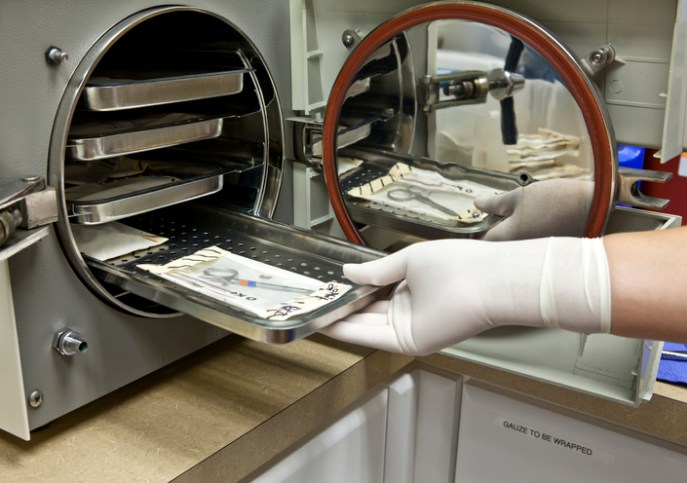A consolidation of several previous standards, ANSI/AAMI ST79:2017 offers a Comprehensive Guide To Steam Sterilization And Sterility Assurance In Health Care Facilities.
How Steam Sterilization Works
Nothing can withstand extreme temperatures, and bacteria is no exception. Generally, an increase in temperature is met with an increase in enzyme activity. However, once an organism reaches its maximum growth temperature, enzyme activity and microbial growth will diminish and the protein will denature. Even bacteria that survives and grows at extreme temperatures—thermophilic organisms—will meet their destruction at a certain limit, since amino acids and nucleotides are destroyed at temperatures over 200°C.
As such, saturated steam under pressure is one of the oldest and safest methods used in health care facilities to sterilize medical devices. Steam, temperature, pressure, and time together assure the effectiveness of this sterilization process to inactivate microbiological activity and secure sanitary equipment in healthcare facilities.
According the U.S. Centers for Disease Control and Prevention (CDC):
“Steam sterilization is nontoxic, inexpensive, rapidly microbicidal, sporicidal, and rapidly heats and penetrates fabrics.”
Why a Comprehensive Guide to Steam Sterilization is Needed
Steam sterilization has been available for many years, and, due to its widespread practice, many might assume the process to be intrinsically controlled and understood. However, the efficacy of any sterilization process, like saturated steam, depends on the success of four critical interdependent phases. To produce and maintain a sterile product, these phases include a consistent system for lowering and limiting bioburden before sterilization, preparing items for sterilization, selecting the sterilization parameters, and establishing and implementing controls to maintain the sterility of sterilized items until use.
Health care facilities differ in their design, equipment, and personnel expertise, competence, and training. Furthermore, sterilization processing activities occur in areas separate from the location where sterilization is carried out. To address these many issues, prior to the initial publication of ANSI/AAMI ST79, there existed numerous standards for steam sterilization, including:
- ANSI/AAMI ST46, Steam sterilization and sterility assurance in health care facilities
- ANSI/AAMI ST42, Steam sterilization and sterility assurance using table-top sterilizers in office-based, ambulatory-care medical, surgical, and dental facilities
- ANSI/AAMI ST37, Flash sterilization: Steam sterilization of patient care items for immediate use
- ANSI/AAMI ST35, Safe handling and biological decontamination of medical devices in health care facilities and in nonclinical settings
- ANSI/AAMI ST33, Guidelines for the selection and use of reusable rigid sterilization container systems for ethylene oxide sterilization and steam sterilization in health care facilities
These five documents were compiled into one to form the initial publication of ANSI/AAMI ST79 in 2003. It is periodically revised to remain current. A single document gathering all this information is crucial for the delivery of sterile health care products for use in patient care, as the efficacy of the sterilization itself is not the only consideration. In fact, those responsible for the sterilization of health care products need to make use of efficient facility design, equipment, personnel (including their education and training), infection prevention and control practices, effective quality control and process improvement systems, and documentation and reporting practices that enable traceability of each facility-sterilized medical device to the patient on whom it was used.
ANSI/AAMI ST79:2017
This document promotes sterility assurance and guides health care personnel in the proper use of processing equipment. In meeting this goal, ANSI/AAMI ST79:2017 includes guidance for sterile processing facility design, personnel, receiving, transporting, handling, cleaning, decontamination, preparation, packaging, steam sterilization of reusable medical devices, quality process improvement, and new product evaluation.
Since its guidance originated in numerous, once-distinct, documents, ANSI/AAMI ST79:2017 applies to a range of interests. Specifically, the recommended practice addresses functional and physical design criteria for sterilization processing areas, along with processing recommendations, quality control, product evaluation, steam sterilizer installation, care, and maintenance, and staff qualifications, education, and other personnel considerations.
Products and Requirements Not Covered by ANSI/AAMI ST79:2017
ANSI/AAMI ST79:2017 does not cover the use of containment devices for packaging items other than instrument sets or procedural trays, the reprocessing of devices labeled for single use only, aseptic presentation, and reusable laboratory items, food service items, and items assigned to a patient for the length of stay (e.g., bedpans, thermometers).
Numerous other equipment, procedures, and requirements excluded from this standard are covered by other American National Standards developed and published by the Association for the Advancement of Medical Instrumentation (AAMI).
Various subjects not covered by ANSI/AAMI ST79:2017 but instead specified by other AAMI standards include:
- Specific construction and performance criteria for steam sterilizers (ANSI/AAMI/ST8:2013 and ANSI/AAMI ST55:2016).
- Rigid, protective organizing cases that require wrapping before sterilization (ANSI/AAMI ST77:2013)
- Procedures and techniques for handling and laundering contaminated reusable surgical textiles (ANSI/AAMI ST65).
- Decontamination of hemodialysis machines (ANSI/AAMI/IEC 60601-2-16:2012).
- Decontamination of hemodialyzers (ANSI/AAMI RD47:2020).
- Decontamination of hemodialyzer blood tubing (ANSI/AAMI/ISO 8638).
- The use of dry heat for decontamination purposes or for terminal sterilization of reusable medical devices (ANSI/AAMI ST40:2004).
- The use of ethylene oxide sterilization in health care facilities for other than decontamination purposes (ANSI/AAMI ST41:2008).
- The use of chemical sterilization and high-level disinfection in health care facilities for other than decontamination purposes (ANSI/AAMI ST58:2013).
